ARCHIVED - Canadian National Report on Immunization, 2006
Volume: 32S3 - November 2006
4. Update on the Epidemiology of Selected Vaccine-Preventable Diseases
The purpose of this section is to provide an update on the epidemiology of selected vaccine-preventable diseases since the 1998 Canadian National Report on Immunization16. Influenza and invasive pneumococcal disease were not discussed in previous immunization reports; summaries of the recent trends of these diseases now under national surveillance have been included in the current report. The information presented in this section summarizes surveillance data from the national systems described in Section 3 of the report and other recent significant disease activity. Data on the vaccine-preventable disease indicators shown in Table 4 are from the NDRS, except where noted. NDRS data are complete and finalized up to 2001. NDRS data for 2002 to 2004 are provisional and subject to change.
Table 4. Disease indicators for selected vaccine-preventable diseases, Canada 1997 to 2004*
| Disease | 1997 | 1998 | 1999 | 2000 | 2001 | 2002 | 2003† | 2004†‡ | ||||||||
| Cases | Rates | Cases | Rates | Cases | Rates | Cases | Rates | Cases | Rates | Cases | Rates | Cases | Rates | Cases | Rates | |
| Diphtheria § | 1 |
0.003 |
0 |
0.0 |
1 |
0.003 |
0 |
0.0 |
0 |
0.0 |
1 |
0.003 |
1 |
0.003 |
1 |
0.003 |
| Invasive Hib disease | 70 |
0.2 |
51 |
0.2 |
21 |
0.07 |
33 |
0.1 |
46 |
0.2 |
45 |
0.1 |
54 |
0.2 |
81 |
0.3 |
| Measles || | 581 |
1.9 |
12 |
0.04 |
29 |
0.1 |
199 |
0.7 |
35 |
0.1 |
7 |
0.02 |
15 |
0.05 |
8 |
0.03 |
| IMD ¶ | 265 |
0.9 |
174 |
0.6 |
214 |
0.7 |
240 |
0.8 |
350 |
1.1 |
233 |
0.7 |
191 |
0.6 |
– |
– |
| Mumps | 264 |
0.9 |
117 |
0.4 |
90 |
0.3 |
87 |
0.3 |
102 |
0.3 |
205 |
0.7 |
20 |
0.06 |
16 |
0.05 |
| Pertussis | 4,280 |
14.3 |
8,910 |
29.5 |
5,847 |
19.2 |
4,751 |
15.4 |
2,946 |
9.5 |
3,217 |
10.2 |
3,229 |
10.2 |
3,120 |
9.7 |
| IPD** | ND |
ND |
ND |
1,350 †† |
4.4 |
1,734 |
5.6 |
2,270 |
7.2 |
2,720 |
8.6 |
2,903 |
9.1 |
|||
| Poliomyelitis | 0 |
0.0 |
0 |
0.0 |
0 |
0.0 |
0 |
0.0 |
0 |
0.0 |
0 |
0.0 |
0 |
0.0 |
0 |
0.0 |
| Rubella | 4,002 |
13.3 |
63 |
0.2 |
24 |
0.08 |
29 |
0.09 |
27 |
0.09 |
15 |
0.05 |
14 |
0.04 |
10 |
0.03 |
| CRS‡‡ | 1 |
0.3 |
1 |
0.3 |
1 |
0.3 |
2 |
0.6 |
0 |
0.0 |
2 |
0.6 |
1 |
0.3 |
3 |
0.9 |
| Tetanus | 4 |
0.01 |
2 |
0.007 |
6 |
0.02 |
4 |
0.01 |
8 |
0.03 |
1 |
0.003 |
1 |
0.003 |
3 |
0.009 |
* Statistics Canada annual population estimates (CANSIM table 051-001) were used to calculated incidence rates per 100,000 population. † NDRS data are provisional for 2003 and 2004. ‡ Data from enhanced disease-specific systems are provisional for 2004. § NDRS reported as diphtheria-like; upon follow-up, cases did not meet case definition of diphtheria. || Based on data from the Enhanced Measles Surveillance System. ¶ Based on data from the Enhanced IMD Surveillance System. ** IPD became nationally notifiable in 2000; ND = no data. †† IPD was not reportable in Ontario until November 2001; Ontario did not submit data to NDRS for 2000. ‡‡ CRS incidence rates are per 100,000 live births. |
||||||||||||||||
4.1 Invasive Haemophilus influenzae type b (Hib) disease
The incidence of invasive Hib disease has declined significantly since 1986, when the first generation of Hib vaccines became available and the disease became nationally notifiable. Further decline has occurred since 1992, when the newer conjugate Hib vaccines were introduced into all routine infant immunization programs. As shown in Figure 1, the average annual incidence during the period 1986-1992 was 1.8 per 100,000 (mean 475 cases per year), compared with 0.15 per 100,000 (mean 47 cases per year) between 1998 and 2004. A decreasing trend is also supported by data from the Canadian Institute for Health Information's Hospital Morbidity Database (HMDB). Although Hib was recognized as the most common cause of bacterial meningitis in Canada until the early 1990s, only 5% of bacterial meningitis hospitalizations captured in the HMDB between 1994 and 1995 and 2000 and 2001 were attributable to Hib17.
Figure 1. Reported cases of invasive Haemophilus influenzae type b disease, Canada, 1986 to 2004
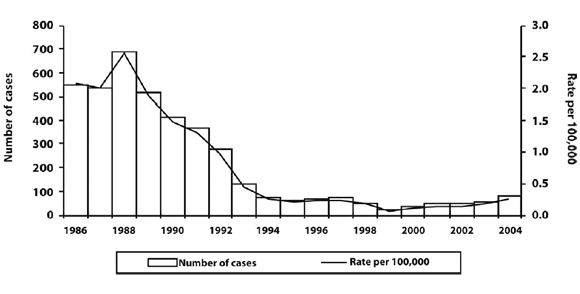
The reduction in the number of reported cases has mostly been among young children. Between 1986 and 1992, 75% of nationally reported cases were children < 5 years of age, compared with 30% of cases reported to NDRS between 1998 and 2004. The number of Hib cases in children < 16 years of age admitted to IMPACT pediatric tertiary care hospitals decreased from 485 cases at 10 centres in 1985 to < 16 cases seen annually between 1996 and 2003 (mean 8.4 cases) at 12 centres. A historic annual low of only three cases was reported by the IMPACT network in 2003. During this latter period, the majority of pediatric cases occurred in children too old to have received vaccination, in unimmunized children or in children too young to have received their primary series. As well, the annual number of vaccine failures after age-appropriate vaccination has been nearly constant, ranging from 1 to 4 cases18.
Although not covered by the Hib vaccine, non-b typeable and non-typeable H. influenzae can rarely cause invasive disease. Of the national surveillance systems, only the ICS monitors invasive disease due to any type of H. influenzae. Between 2000 and 2004, 51 cases of invasive H. influenzae were detected in northern Canada by ICS. Of these, only five cases (11% of 47 with serotype information) were due to serotype b; 55% of cases were caused by serotype a, and 28% of invasive disease involved non-typeable isolates. Serotypes c, d and e were each isolated in one case of invasive disease.
4.2 Hepatitis B
Interpretation of hepatitis B virus (HBV) incidence rates in Canada has been confounded by inconsistencies in reporting acute versus prevalent (chronic) infections19. To address this issue, in 1998, an Enhanced Hepatitis Strain Surveillance System (EHSSS) was initiated to provide a more accurate estimate of infection levels of hepatitis. Eight sites across Canada representing approximately 27% of the Canadian population collect data on acute and chronic hepatitis B and C infections, risk factors associated with infection and viral genotype information19.
Data from seven of the eight EHSSS sites show that overall incidence rates for acute hepatitis B declined significantly from 2.05 per 100,000 in 1999 to 0.93 per 100,000 in 2004. The decline in incidence was seen in most age groups. There was a 75% decrease in the number of cases in the 30 to 39 year age group, a 72% decrease in those aged 10 to 19 years and a 64% decrease in the number of cases in the 20 to 29 year age group. Rates were 2.8 times higher among males20.
The reported cases likely represent an underestimate of the true incidence of infection as a result of underreporting and subclinical infections. Likewise these factors may affect the annual incidence estimates, but should not affect the incidence trend over time.
Since the EHSSS covers only 27% of the Canadian population, data may not be representative of all of Canada, as certain cities with a high density of immigrant populations (e.g. Montreal and Toronto) did not contribute to the system.
4.3 Influenza
Laboratory data
Over the past 9 years, the number of laboratory tests for influenza conducted by sentinel laboratories has risen substantially, from 26,991 tests in 1996-1997 to 101,258 tests in 2004-2005. The 3.8-fold increase in testing is likely related to multiple factors unrelated to seasonal severity, including an increase in testing by clinicians and an increase in the number of sentinel laboratories participating in the FluWatch program, from 25 in 1996 to 33 in 2005. The number of tests positive for influenza has risen 5.5-fold from 2,347 in 1996-1997 to 12,879 in 2004-2005. The three seasons with the highest percentage of positive influenza tests were 1999-2000, 2003-2004 and 2004-2005 (12% to 13%). The three seasons with the lowest percentage were 1996-1997 (8.7%), 2000-2001 (7.6%) and 2002-2003 (5.8%). In addition to the severity of the season, the increase in percentage of positive influenza tests over the years may be related to improved clinician swabbing technique with greater experience and more appropriate testing of only those persons meeting the case definition for ILI.
As shown in Figure 2, six of the past nine seasons (1997-1998, 1998-1999, 1999-2000, 2001-2002, 2003-2004, 2004-2005) have been characterized as predominantly influenza A seasons (86% to 99% of laboratory detections being influenza A). Two seasons (1996-1997 and 2002-2003) were mixed seasons, and one season (2000-2001) was characterized as a predominantly influenza B season. Strains with the H3N2 subtype of influenza A evolve more rapidly and cause more frequent and intense seasonal outbreaks than those belonging to the influenza A H1N1 subtype or to influenza B. Influenza A is also typically associated with greater morbidity and mortality than influenza B and usually affects the elderly, whereas influenza B is more often seen in young children. In four of the six predominantly influenza A seasons, 41% to 46% of laboratoryconfirmed influenza cases were in persons ≥ 65 years of age, whereas children < 5 years of age accounted for < 20% of laboratory-confirmed cases. In the mixed seasons and the predominantly influenza B season, children < 5 years of age accounted for 24% to 32% of laboratory-confirmed cases, whereas persons ≥ 65 years of age accounted for 7% to 19%.
Three influenza seasons (1996-1997, 1998-1999 and 2000-2001) saw known circulating strains match well with those in the available influenza vaccine. In one season (1997-1998) there was a mismatch in the A(H3N2) component of the vaccine. This was the first season that the A/Sydney/5/97(H3N2)-like virus was known to circulate in Canada, and the season was assessed as being a severe epidemic season. In the 2003-2004 season, there was a mismatch in all components of the vaccine [A(H3N2), A(H1N1) and B]; this season was considered to be of moderate severity. In the 2004-2005 season, a relatively severe season characterized by large numbers of outbreaks in long-term care facilities (LTCFs), the emergence of the A/California/7/2004 H3N2 strain resulted in a vaccine mismatch. There were mismatches in the vaccine and circulating strains for 2001-2002 and 2002-2003; however, these seasons were considered relatively mild.
ILI consultation rates
Expected rates (mean and 95% confidence interval [CI]) were calculated for each season (October through May) based on the other eight seasons from 1996-1997 through 2004-2005. Three influenza seasons (1996-1997, 1997-1998 and 1999-2000) had 50% or more weeks with ILI consultation rates exceeding these expected rates. One season (1998-1999) saw 33% of weeks exceeding expected ILI consultation rates, and the remaining five seasons (2000-2001 through 2004-2005) saw 0% to 15% of weeks exceeding expected values for ILI consultation rates.
Influenza activity levels
The FluWatch program has been collecting data on influenza activity level for provincially/territorially assigned surveillance regions on a weekly basis since 1997-1998. Using the number of times that widespread influenza activity was reported in a season as a measure of severity, the seasons with the highest percentage of widespread activity levels were 1997-1998 (50%), 1998-1999 (31%) and 1999-2000 (31%). The seasons with the lowest percentages were 2001-2002 (8%), 2002-2003 (14%) and 2000-2001 (20%). Caution must be used when comparing seasonal influenza activity levels because of (1) increases in the number of surveillance regions (10 provinces and two territories reporting in 1997-1998, which were subsequently subdivided into > 50 regions beginning in 2000) and the number of weeks of influenza activity level reporting per season; (2) decreases in incomplete reporting from 11% to 18% of surveillance regions in the late 1990s to between 0.2% and 8% of surveillance regions during the early to mid-2000s; and (3) the substantial variation in the application or interpretation of activity levels by P/T, despite the provision of standard definitions set in 1997.
Outbreaks in LTCFs
Since the 1999-2000 influenza season, P/T have been reporting the number of laboratory-confirmed influenza outbreaks in LTCFs to PHAC. The number of reported outbreaks has increased each year, from three outbreaks in 1999-2000 to 793 in 2004-2005. In addition to any annual variations in epidemiologic impact, this increase is likely also an artefact related to improved reporting over the years. Interestingly, in the late 1990 seasons when the numbers of reported outbreaks were lowest, the ratios of widespread to localized influenza activity levels were highest. These findings suggest that outbreaks were substantially underreported in the early years of the FluWatch Program.
IMPACT data
IMPACT implemented a pilot program to collect data on pediatric hospital admissions with laboratoryconfirmed influenza from nine sites in 2003-2004 and, in 2004-2005, these data were collected from all 12 IMPACT sites. During the 2003-2004 influenza season, IMPACT reported 505 pediatric hospital admissions with laboratory-confirmed influenza: 500 (99%) were influenza A and 5 (1%) were influenza B. Three deaths were reported (0.6% case fatality). Fifty-seven percent of cases were < 2 years of age. Previously healthy children admitted with influenza infections were approximately three times more likely to be < 2 years of age than aged ≥ 2 years (odds ration [OR] = 3.0, 95% CI 2.0-4.4, p < 0.0001). In the 2004-2005 influenza season, IMPACT reported 391 pediatric hospital admissions with laboratoryconfirmed influenza: 271 (61%) were influenza A and 120 (39%) were influenza B. Two deaths were reported (0.5% case fatality). Fifty-five percent of cases were < 2 years of age. Previously healthy children admitted with influenza infections were approximately four times more likely to be < 2 years of age than aged ≥ 2 years (OR = 4.5, 95% CI 2.9-7.2, p < 0.0001)21. Although it is not possible to determine trends in pediatric morbidity and mortality with only 2 years of data, preliminary findings support the recent NACI recommendation that all healthy children aged 6 to 23 months receive influenza immunization.
Overall, surveillance data appear to indicate that the influenza seasons in the early to mid-2000s were relatively milder than the seasons in the late 1990s when the A/Sydney/5/97(H3N2)-like viruses were circulating. Influenza surveillance has improved substantially in the past 9 years, both in terms of the quality of data and the addition of important indicators. These indicators, when assessed in combination, provide a good description of national influenza activity each season. However, the addition of real-time data on influenza-related severe morbidity (hospital admissions) and mortality in adults would provide a better description of influenza severity by season and allow for more informative evidence-based policy decisions.
4.4 Measles
The epidemiology of measles in Canada and progress towards elimination has been discussed in detail in recent publications3,16,22. King et al. summarized the current situation in Canada and outlined progress towards measles elimination up to 200423. The latter publication highlighted a 96% decline in the average annual incidence of measles since the introduction of routine two-dose immunization and catch-up campaigns in 1996-1997 (Figure 3). The dramatically reduced number of measles cases reported in Canada and the lack of sustained transmission from sporadic importations are attributed to the success of these immunization initiatives.
In recent years, measles cases reported in Canada have been limited to sporadic importations linked to endemic countries, with occasional outbreaks. In recent years, larger outbreaks consisting of more than 10 cases have been associated with undervaccinated communities22. Since the last Canadian National Report on Immunization, when a new low of 12 cases was reported for 1998, the number of cases reported annually has remained under 35 except for the year 2000. In 2000, a total of 199 cases were reported, all of which were either sporadic imported cases (3%) or imported cases and their associated outbreak cases (97% involving 2, 6, 30 and 155 cases in Ontario, Alberta, Quebec and British Columbia/Alberta, respectively)23.
The lowest number of cases reported for any year to date in Canada was six cases reported in 2005. Four of the six cases were imported or import-related following exposure in the United States (source not identified). The remaining two cases identified in 2005 were sporadic cases with no travel history and no identified source of exposure in Canada. Similarly, all but one of eight cases identified the previous year occurred secondary to travel or contact with a traveler outside of Canada.
The 2004 NICS indicated that 94% of children received one dose of MMR by their second birthday and approximately 78% received two doses by their seventh birthday (see section on 2004 NICS). While these achievements are below the recommended 97% targets for these age groups, coverage has so far been sufficiently high in the general population to prevent re-establishment of endemic transmission. Nevertheless, the goal of measles elimination will be achievable only if two-dose vaccine coverage is maintained at very high levels23 .
Figure 3. Reported cases of measles, Canada, 1996 to 2005
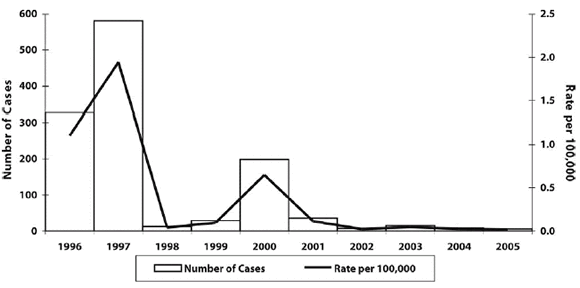
4.5 Invasive Meningococcal Disease (IMD)
IMD is endemic in Canada with periods of increased activity occurring roughly every 10 to 15 years but with no consistent pattern. The incidence rate varies considerably with different serogroups, age groups, geographic locations and time. IMD has been a nationally reportable disease in Canada since 1924 through the NDRS. Since 1985, additional data elements have been collected through enhanced surveillance from all P/T.
As shown in Figure 4, the overall annual incidence of IMD has remained at or below 2 per 100,000 (range 0.5 to 2.1) since 1985. Overall, the incidence rate has been highest among children < 1 year of age, and then declines as age increases except for a smaller peak in the 15 to 19 year age group. An average of 303 cases of meningococcal disease were reported annually between 1995 and 2003. Disease occurs year-round; however, there is seasonal variation, the majority of cases occurring in the winter months.
Serogroups A and C Neisseria meningitidis were the groups most frequently identified from 1971 to 1974. From 1975 to 1989, serogroup B predominated, the majority being serotypes 2b, 4 and 15 and the most common subtype P1.2. In 1986, a new clone of serogroup C, serotype 2a, characterized as electrophoretic type 15 (ET-15), was identified in Canada for the first time and is currently responsible for most of the serogroup C disease reported in Canada.
Since 1993, serogroups B and C have been responsible for most of the cases of endemic disease in Canada (incidence rates ranging between 0.13 and 0.65 per 100,000 for serogroup C and 0.2 and 0.44 per 100,000 for serogroup B). However, there has been less fluctuation in the incidence of serogroup B than of serogroup C disease over time. Serogroup C isolates have almost exclusively been responsible for outbreaks; there were sporadic localized outbreaks and periods of elevated incidence of serogroup C disease during 1989 to 1993 (mean 1.49 cases per 100,000 per annum) and 1999 to 2001 (mean 0.87 cases per 100,000 per annum). During these years, incidence increased in particular among persons aged 15 to 19 years(11). Immunization campaigns for serogroup C IMD using polysaccharide and conjugate vaccines were implemented in some regions during that period.
Since 2001, NACI has recommended meningococcal conjugate C vaccine for all Canadian children < 5 years of age, adolescents and young adults. The extent to which the NACI recommendations have been implemented varies throughout the country. By July 2005, 12 of 13 P/T had implemented a universal meningococcal C conjugate vaccination program at various ages. Initial surveillance data indicate that vaccination against serogroup C disease may be having an impact on the epidemiology of IMD in Canada; however, because of the cyclical nature of the disease, ongoing surveillance is essential.
Figure 4. Reported cases of IMD, Canada, 1985 to 2003
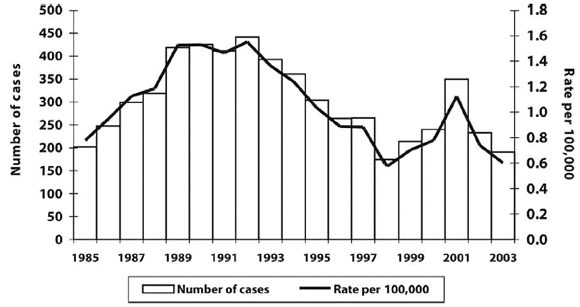
4.6 Mumps
Since the Canadian National Report on Immunization, 1998, the number of mumps cases reported to the NDRS has continued to decline, except for the number in 2002. As illustrated in Figure 5, the average annual incidence dropped by 74%, from 1.2 per 100,000 (354 cases per year) during 1990 to 1997 to 0.3 per 100,000 (99 cases per year) during 1998 to 2001. In 2002, the annual incidence rose to 0.7 per 100,000 (205 cases), largely as a result of an outbreak in an under-vaccinated community in northern Alberta, which declined vaccination for philosophical reasons.
The Alberta outbreak began in September 2001, peaking in March 2002 and ending in August 2002 with a total of 193 cases. The index case was an imported case involving an unimmunized child whose family had moved from Bolivia while the child was acutely ill. Following the initial importation, the outbreak spread through area schools (152/193 or 79% of cases were students) and to a lesser extent the surrounding community (41/193 or 21% of cases). Just over half (54%) of those affected were females, and the average age of the cases was 12.2 years (range 8 months to 47 years; median 10 years). With immunization rates in the affected community significantly below the provincial average for Alberta (< 43% of individuals had been immunized with two doses of mumps vaccine), the majority of cases (155/193 or 80%) occurred in unimmunized individuals (A. Honish, Alberta Health and Wellness: personal communication, 2005).
Previous outbreaks had been reported in 1997 and 1998. The 1997 outbreak of 51 cases occurred in teenagers and young adults and was related to attendance at a rave party in British Columbia24,25. The 1998 outbreak of 37 cases occurred in school children from families in Quebec who had recently emigrated from countries where mumps vaccine was not included in the routine childhood immunization program26.
Preliminary data for 2003 and 2004 indicate that fewer than 30 cases were reported annually during this period, the lowest incidence ever recorded in Canada. No outbreaks were reported. However, in 2005 two outbreaks were reported in Nova Scotia. In the spring of 2005, the first of these involved 13 cases, ages 13 to 19 years (mean 14 years). This was followed by a second outbreak occurring between September 2005 and January 2006 and involving 19 cases in university students, ages 20 to 27 years (mean 23 years). This second outbreak led to three secondary cases reported in Ontario. While most cases (9/13) in the first cluster had received two or more doses of MMR, only one of the 19 cases in the second outbreak had received two doses of MMR.
As with other vaccine-preventable diseases that are uncommon in the highly vaccinated general population, occasional outbreaks may still affect under-immunized pockets of the population. Importation from countries with low vaccine coverage rates presents an ongoing risk to under-vaccinated individuals and communities. With sustained high coverage rates, these sporadic importations are not expected to result in any sustained transmission in the general population.
Figure 5. Reported cases of mumps, Canada, 1990 to 2004

4.7 Pertussis
As shown in Figure 6, after a historic low incidence rate of 4.1 per 100,000 in 1988, the national incidence of reported pertussis increased between 1989 and 1998, peaking in 1994 at 34.8 per 100,000. There was a series of large outbreaks in several provinces during that period. The outbreaks occurred in progressively older age groups, the 1988-1992 birth cohorts being most susceptible to illness27-29. The resurgence in pertussis has been attributed to the low efficacy of the combined adsorbed diphtheria-tetanus-pertussis whole cell vaccine used in children in Canada between 1980 and 1997, waning of vaccine-induced immunity among older adolescents and adults, increased physician awareness and improved diagnosis and reporting of pertussis disease.
Figure 6. Reported cases of pertussis, Canada, 1985 to 2004
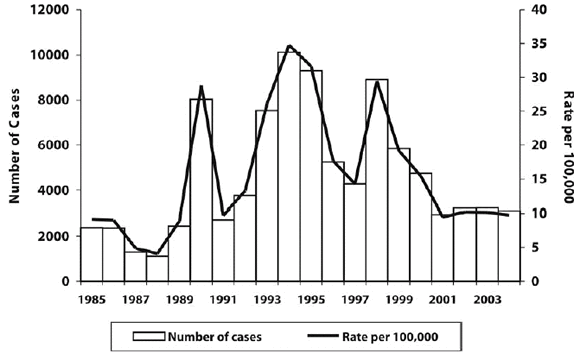
Since the replacement of adsorbed whole cell vaccine with the more efficacious and less reactogenic acellular pertussis vaccine in all P/T during 1997-1998, the national incidence of pertussis has declined. According to preliminary data for 2004, the crude incidence rate was 9.7 per 100,000 (3,120 cases). Children < 1 year old continue to have the highest age-specific incidence at 92.2 per 100,000 (309 cases). Ten- to 14-year olds, who would have only received whole cell pertussis vaccine, had the second highest incidence, of 50.7 per 100,000 (1,074 cases). Younger children who have lived through the acellular period and have been exposed to a greater number of acellular vaccine doses had lower pertussis rates, at 21.6 per 100,000 (295 cases) in the 1 to 4 year age group and 19.5 per 100,000 (373 cases) in the 5 to 9 year age group.
Pertussis is most severe among children < 1 year of age. Thirteen deaths due to pertussis were reported to the Statistics Canada Deaths Registry between 1995 and 2000, and 85% of these occurred in children < 4 months of age. Children in this age group would have been too young to receive immunization protection or would have received only one dose of the vaccine. Similarly, of 16 deaths reported by pediatric tertiary care centres of the IMPACT network between 1991 and 2001, 13 were < 2 months of age, and three deaths were in children between 2 and 6 months of age30.
Pertussis has been increasingly recognized as a cause of prolonged cough illness among adults and adolescents, but it is often under-diagnosed in these age groups because of nonspecific symptoms31. In September 2003, NACI recommended that all pre-adolescent and adolescent children should receive a single dose of the adult formulation of acellular pertussis vaccine, and that adults who had not previously received a dose of acellular vaccine receive the combined diphtheria-tetanus-acellular pertussis (Tdap) vaccine rather than a single diphtheria-tetanus (Td) booster dose. The immunization of adults and adolescents may also indirectly protect infants32. By September 2004, all P/T had implemented adolescent acellular pertussis vaccine programs. Although it is too early to assess the national impact of these programs, an overall decrease has been observed in the Northwest Territories, which was the first jurisdiction to implement an adolescent pertussis program in October 2000. The average incidence per 100,000 for the territory decreased from 7.5 between 1993 and 1996 (whole-cell vaccine era) to 7.2 between 1997 and 2000 (after introduction of the child formulation of acellular pertussis vaccine) to 1.1 between 2001 and 2004 (after introduction of the adolescent Tdap program)33. Continued close monitoring will help to determine whether these reductions will be seen across the country over time.
4.8 Invasive pneumococcal disease
Streptococcus pneumoniae is an important cause of morbidity and mortality in adults and children worldwide. Invasive pneumococcal disease (IPD) is most common in the very young, the elderly and persons with certain underlying illnesses, including asplenia; HIV infection and other conditions causing immunosuppression; diabetes; cerebral spinal fluid leak; alcohol abuse; and chronic cardiovascular, pulmonary or liver diseases.
Between 1979 and 1999, only pneumococcal meningitis was nationally notifiable; the overall annual incidence rates during this period ranged from 0.05 to 0.50 per 100,000. However, meningitis accounts for only a small proportion of all invasive disease due to S. pneumoniae. Population-based studies conducted during the mid-1990s estimated that the annual incidence rate for IPD was between 11.6 and 17.3 per 100,00034. IPD became nationally notifiable in 2000 and includes laboratory-confirmed pneumococcal meningitis, pneumonia with bacteremia, and bacteremia without a known site of infection. Although well below original estimates, national rates of IPD have increased from 4.4 per 100,000 (1,350 cases) in 2000 to 9.1 per 100,000 (2,903 cases) in 2004, indicating improved reporting over time. In 2004, the age-specific incidence rates were highest among children < 1 year of age, at 42.1 per 100,000 (141 cases), followed by children 1 to 4 years of age at 31.2 per 100,000 (426 cases). The incidence rate of IPD was lower among adolescents and younger adults, increasing among adults 60 years of age and older to 20.6 per 100,000 (1,158 cases).
Elevated rates of IPD have been detected in northern Canada by the ICS. Between 1999 and 2004, the crude annual incidence ranged from 21.8 to 38.4 per 100,000, with age-specific incidence rates for the entire period highest among children < 2 years, at 147.8 per 100,000. The crude incidence rate was higher among Aboriginals during 1999-2004, at 38.0 per 100,000, than non-Aboriginals, at 9.6 per 100,000 (ICS, unpublished data, 2006).
The 23-valent polysaccharide vaccine (Pneu-P-23), which is recommended for adults ≥ 65 years of age and persons > 5 years who are at greater risk of disease, has been available in Canada since 1983. In January 2002, NACI recommended the use of 7-valent pneumococcal conjugate vaccine (Pneu-C-7) in routine infant immunization programs; all 13 provinces and territories had implemented Pneu-C-7 programs by January 2006.
Recent data from the IMPACT network suggest a shift towards S. pneumoniae serotypes that are not included in Pneu-C-7. Of the 1,774 cases of IPD seen in inpatients and outpatients < 16 years of age at IMPACT pediatric tertiary care centres between January 1998 and January 2004, the proportion of serotypes matching those in Pneu-C-7 decreased from 81.2% between 1998 and 2000 to 77.1% between 2001 and 2004 (p = 0.04). However, this shift appears unrelated to vaccine use, as most jurisdictions did not implement their routine infant Pneu-C-7 programs until 2004-2005. Overall, 59% of cases reported during this period occurred in children < 2 years of age, 30% in children with underlying conditions or other risk factors for IPD, and 2.7% of cases resulted in death35.
It is too early to assess the impact of these infant Pneu-C-7 programs nationwide. However, a prompt and large decline in the incidence of IPD among children < 2 years of age has been observed in population-based surveillance in the Calgary Health Region. Alberta was one of the first jurisdictions to introduce a universal infant Pneu-C-7 program, in September 2002. Compared with the combined IPD rate of 53.0 per 100,000 among children < 2 years old between 1998 and 2001, the rate in 2004 decreased by 81.6% to 11.7 for all serotypes (p = 0.02), by 92.6% to 3.9 for Pneu-C-7 serotypes (p < 0.001) and by 93.4% to 3.9 for Pneu-C-7 and related serotypes (p < 0.001); there was no change for non-Pneu-C-7 serotypes. There was also a significant decline in the incidence of IPD among adults ≥ 65 years, which was likely due to the indirect effect of Pneu-C-7 rather than a direct effect of Pneu-P-23 programs in older adults36. The national incidence of IPD is expected to similarly decline across Canada because more infants are now being immunized against the disease (Table 1).
4.9 Poliomyelitis and acute flaccid paralysis (AFP) surveillance
The last case of wild paralytic poliomyelitis in Canada was an imported case reported in 1988 (the last indigenous case was reported over a decade earlier, in 1977). Maintaining vigilance in the absence of disease is a challenge; however, until global eradication is achieved the risk of importation of wild poliovirus remains. Therefore, syndromic surveillance and follow-up investigation of AFP in children < 15 years of age continues to be used to monitor for potential cases of paralytic poliomyelitis. The expected background rate of AFP in the absence of wild poliovirus transmission according to the World Health Organization (WHO) is 1 per 100,000 of the population aged < 15 years. This equates to approximately 60 cases per year in Canada. However, since 1996, an average of only 0.77 per 100,000 or 45 cases (range 0.50 to 1.04 per 100,000 or 30 to 61 cases) of AFP have been reported each year in Canada. The AFP reporting rate initially increased following the introduction of enhanced surveillance in the early 1990s, reaching the 1 per 100,000 target rate in 1999 and 2000, then fell again to < 45 cases per year in 2002 to 2004 (Figure 7). The reasons for not meeting this target are not entirely clear, given current active enhanced surveillance systems, including the CPSP network of pediatricians and the IMPACT network of pediatric tertiary care centres across Canada.
Figure 7. Non-polio AFP reporting rate, Canada, 1996 to 2005
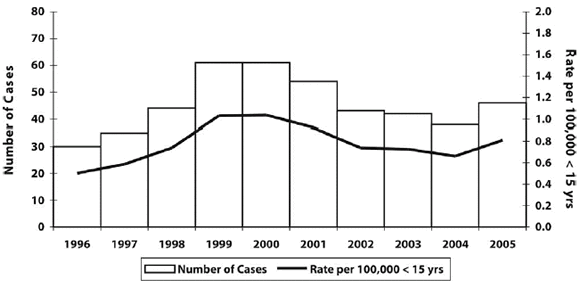
4.10 Rubella
Despite occasional outbreaks, the most recent of which occurred in south-western Ontario in 2005, the incidence of rubella has maintained a steady decline in Canada over the past two decades. In particular, following the introduction of routine infant immunization programs for MMR across Canada in 1983, the average number of reported cases per year decreased from approximately 5,300 per year (1971 to 1982) to < 30 cases per year (1998 to 2004) (Figure 8). Further, following the introduction of two-dose MMR schedules introduced in 1996-1997, the average incidence decreased from 0.08 per 100,000 in 1999 to 0.03 per 100,000 in 2004 (range 0.03 to 0.09 per 100,000), and the previously observed peaks in incidence have become less apparent. Nevertheless, outbreaks have occurred, because of either gaps in overall population coverage (pre-1983 selective immunization programs) or under-vaccination of individuals and communities (due to emigration from areas of low MMR coverage or refusal of MMR vaccination for philosophical reasons).
In 1997, a large outbreak in Manitoba affected mostly non-immunized males aged 15 to 24 years and was attributed to gaps in vaccination coverage that resulted from early selective immunization programs targeting pre-adolescent females in some jurisdictions. This outbreak resulted in incidence rates approximating 350 cases per 100,000. This is reflected as a sharp increase in the national incidence rate for 1997 (Figure 8), wherein 98% of the total reported cases for Canada were associated with the Manitoba outbreak.
In 2005, a total of 309 laboratory-confirmed cases were reported in association with an outbreak of rubella in south-western Ontario. This outbreak, which ended in late July 2005, affected both sexes roughly equally (male:female ratio 1.07), as well as all age groups. However, children aged 5 to 14 years were the most affected age group, accounting for over 60% of cases. In addition, 10 of the cases were pregnant women. At the time of writing this report, all of the pregnant women had delivered, and no cases of congenital rubella syndrome or congenital rubella infection had been reported in association with the outbreak. Unlike the 1997 Manitoba outbreak, the Ontario outbreak has been attributed to under-vaccination of persons within a defined religious community (over 98% of cases were unvaccinated) who are philosophically opposed to immunization. Preliminary laboratory evidence has linked the Ontario outbreak to an earlier outbreak in the Netherlands, which began in September 2004 and continued through to July 2005. The Netherlands outbreak resulted in 387 laboratory-confirmed cases in an unimmunized religious community. The Ontario community where the outbreak occurred has historical and social links with the affected community in the Netherlands, including frequent travel of individuals between the two communities (S. Hahné, Centre for Infectious Disease Control, the Netherlands: personal communication, 2005)37,38.
As demonstrated by these recent outbreaks, rubella cases in Canada are increasingly limited to under-immunized individuals or groups within the general population. With established and maintained high MMR coverage rates, these outbreaks have not resulted in sustained transmission outside of the affected groups. However, unimmunized individuals, including those philosophically opposed to immunization as well as those immigrating to Canada from countries where rubella vaccine coverage is inadequate, will continue to pose a risk for future outbreaks.
4.11 CRS and congenital rubella infection
The primary goal of rubella immunization is to prevent infection in pregnancy and thereby eliminate the sequelae, namely CRS and congenital rubella infection (CRI), which can occur in infants born to infected mothers. Enhanced surveillance of CRS/CRI was initiated through the Canadian Paediatric Surveillance Program (CPSP) in 1996 with the aim of supplementing pre-existing surveillance activities to increase case finding and to initiate surveillance for CRI. While the CPSP has been a valuable means of increasing the profile of CRS and CRI through regular communications with pediatricians across Canada and annual reports on surveillance findings, after 9 years it has been decided that parallel reporting mechanisms, such as NDRS and enhanced P/T reporting, are best suited for the future of CRS/CRI surveillance in Canada. During the period of reporting through the CPSP, 1996-2004, no cases of CRI and just 10 cases of CRS were reported, most of which were reported to the NDRS in parallel. The lack of CRI reports and rarity of CRS reports over 9 years can be largely attributed to the low incidence of rubella in Canada but may also be due to underreporting and/or under-diagnosis of the various manifestations of mother-to-child rubella infection, including CRI, CRS with severe manifestations and CRS with late-onset manifestations.
Figure 8. Reported cases of rubella, Canada, 1971 to 2005
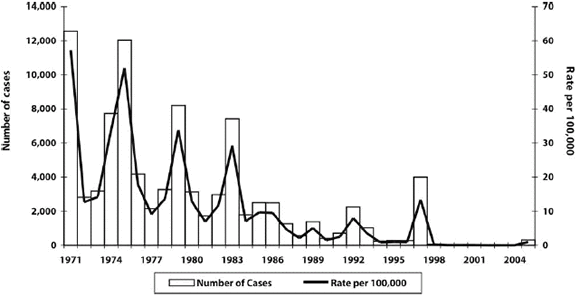
Between 1980 and 2004, the incidence of CRS appeared to follow the same trend as that of rubella (Figure 9), with the exception of the 1997 Manitoba outbreak, which involved mainly young males aged 15 to 24 years (86%). Of the 10 CRS cases reported through the CPSP between 1996 and 2004, eight had information available: five were born to immigrant women, one to an Aboriginal woman and two to non-Aboriginal women. In 2005, a single case of CRS was reported in British Columbia; the mother of the case immigrated to Canada 1 month before the infant's birth. To date, no cases of CRS or CRI have been reported in association with the 2005 outbreak of rubella in south-western Ontario, which involved 10 pregnant women, all of whom had delivered at the time of writing this report.
In Canada, routine infant and childhood catch-up immunization programs, aimed at increasing MMR coverage, have resulted in sustained high rates of immunity in the general population4. Together with CRS-specific policies to screen 100% of pregnant women for rubella and to offer immunization to all women who are susceptible postpartum (implemented in six provinces and one territory), Canada is making progress towards elimination of indigenous rubella infection in pregnancy. Yet while the rarity of CRS/CRI in Canada is a reflection of the impact of these rubella elimination strategies, the risk of importation and limited transmission remains, for the reasons discussed earlier (see rubella section).
4.12 Varicella
Varicella (chickenpox) infections are significantly under-reported in Canada. It is estimated that 90% of the population will have had chickenpox by the time they are 12 years of age and as many as 350,000 cases are expected to occur each year39,40. However, < 10% of these infections are reported to the Notifiable Diseases Reporting System (NDRS) in any given year. While varicella is a notifiable disease, only laboratory-confirmed cases or clinical cases linked to laboratory-confirmed cases are captured by the case definition and not all P/T participate in routine reporting at the national level. Furthermore, herpes zoster (shingles) cases or latent reactivation of varicella virus infections are not nationally notifiable in Canada. Given that the estimated lifetime risk of experiencing at least one reactivation of primary varicella infection to herpes zoster is 15% to 20%, there are likely a significant number of these infections unaccounted for at the national level40.
Figure 9. Incidence rates of CRS and rubella, Canada, 1980 to 2005
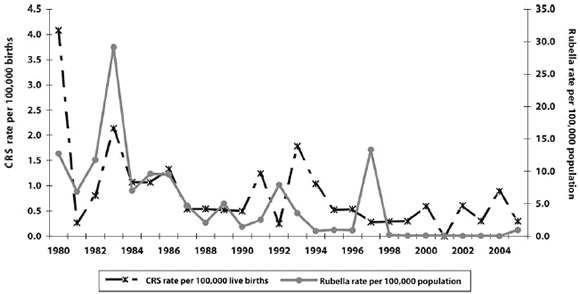
Supplementary surveillance data are available for paediatric varicella and herpes zoster hospitalizations through IMPACT. The first period of surveillance ran from 1990 to 1996 and was re-initiated in 1999 after a 3-year hiatus. Results for the first period of surveillance have been published previously41. For the most recent period to date, 1999 to 2005, a total of 2,358 hospitalizations due to varicella or herpes zoster were reported from the 12 sites across Canada, averaging 335 hospitalizations each year (range 246 to 455) (IMPACT, unpublished data, 2006). Of these cases, just over half were male (55%), and the most affected age groups were 1 to 4 years (45% of hospitalizations) and 5 to 9 years (30% of hospitalizations). As noted for the previous surveillance period, the majority of hospitalizations occurred in previously healthy children41. Pediatric deaths due to varicella are relatively uncommon; case fatality rates are highest among adults (30 deaths per 100,000 cases), followed by infants (seven deaths per 100,000 cases) and children aged 1 to 19 years (one to 1.5 deaths per 100,000 cases)39,40,42. In Canada, of the 53 reported varicella deaths from 1987 to 1996, 70% occurred in those > 15 years of age39. Since 1999, a total of seven deaths due to varicella were reported by IMPACT, ranging from 0 to three deaths per year. During the same time period, IMPACT reported one death due to herpes zoster.
Given that varicella is mainly a childhood disease, with healthy children < 12 years of age accounting for approximately 90% of all varicella cases39 and the majority of hospitalizations, sentinel data from the IMPACT surveillance system provide important information on varicella and herpes zoster complications and trends in disease severity. However, the absence of adequate population-based surveillance presents a challenge for both a description of current trends in varicella and herpes zoster infections and for ongoing monitoring of disease incidence trends. Given that nearly all P/T have now implemented routine infant immunization programs for varicella, surveillance data will be important in monitoring the impact of these programs on varicella incidence in Canada and likewise on the incidence and potential shifting age patterns of herpes zoster reactivation.
Page details
- Date modified: